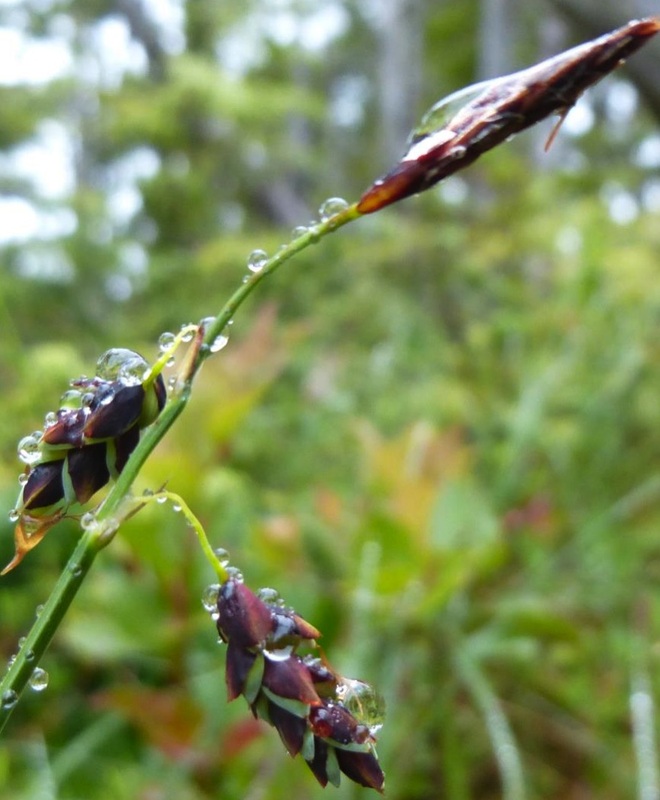Several-flowered sedge, many-flowered sedge • Carex pluriflora
{pluriflora = several-flowered}
|
Identification This species grows in loose tufts composed of one to a few stems. The stems grow 20-60 cm tall from roots covered in a yellow layer. This species' rhizomes are long and purplish black. The leaves are glaucous (covered with a white, waxy layer), loosely sheath the stem, and about the same length as the stem. The terminal male inflorescence (top right of above photo) is upright, and the lower 1-3 female spikes droop down on long, thin stalks. The lowest spike bract is short and bristle-like. The spikes bear triangular, plump (not flat in cross-section) perigynia (sac covering reproductive parts and fruit), which are visible on the spikes in the above photo. These perigynia range from pale green to blackish brown. Click here to read a more detailed description, and for some useful illustrations. |
Habitat & Range
Several-flowered sedge grows in bogs, marshes, along streams, and in wet meadows, from low to middle elevations. It is a common species in Coastal BC, and its west coast range stretches from Alaska to Oregon. It is also found along the coasts of eastern Asia.
Similar Species
Shore sedge and poor sedge are similar-looking but less common species in coastal habitats. They both have bluish-green perigynia, whereas several-flowered sedge has pale green to blackish-brown perigynia. Several-flowered sedge perigynia are plump as well, whereas the two other species have flat perigynia.
Several-flowered sedge grows in bogs, marshes, along streams, and in wet meadows, from low to middle elevations. It is a common species in Coastal BC, and its west coast range stretches from Alaska to Oregon. It is also found along the coasts of eastern Asia.
Similar Species
Shore sedge and poor sedge are similar-looking but less common species in coastal habitats. They both have bluish-green perigynia, whereas several-flowered sedge has pale green to blackish-brown perigynia. Several-flowered sedge perigynia are plump as well, whereas the two other species have flat perigynia.
References
Carex pluriflora Hulten. In Klinkenberg, Brian. (Ed.). E-Flora BC: Electronic Atlas of the Plants of British Columbia. Lab for Advanced Spatial Analysis, Department of Geography, University of British Columbia, Vancouver. Accessed 03/07/2013.
Pojar, J. and MacKinnon, A. (1994). Plants of Coastal British Columbia. Vancouver, BC: Lone Pine Publishing. P. 401.
Authors and editors of page
Kelly Fretwell and Brian Starzomski (2013).
Carex pluriflora Hulten. In Klinkenberg, Brian. (Ed.). E-Flora BC: Electronic Atlas of the Plants of British Columbia. Lab for Advanced Spatial Analysis, Department of Geography, University of British Columbia, Vancouver. Accessed 03/07/2013.
Pojar, J. and MacKinnon, A. (1994). Plants of Coastal British Columbia. Vancouver, BC: Lone Pine Publishing. P. 401.
Authors and editors of page
Kelly Fretwell and Brian Starzomski (2013).




